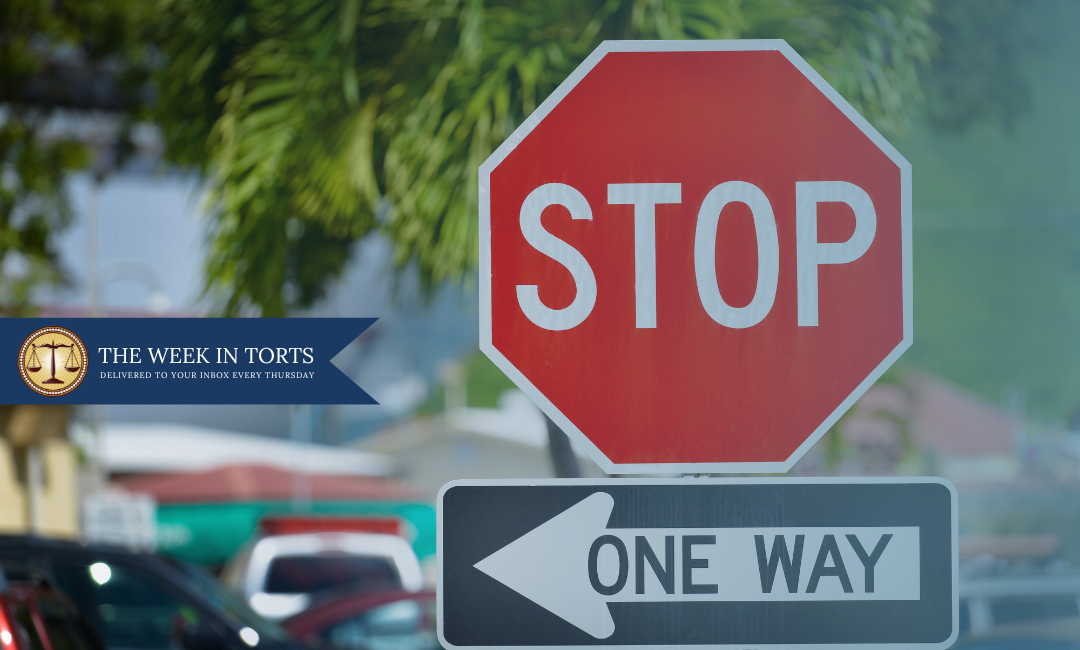The Week In Torts – Cases from December 8, 2023

You forgot to compare the fault.
FLORIDA LAW WEEKLY
VOLUME 48, NUMBER 49
CASES FROM THE WEEK OF DECEMBER 8, 2023
COURT FINDS PCA ON EARLIER SOVERIGN IMMUNITY APPEAL TO BE “LAW OF THE CASE” – – ORDERS A NEW TRIAL ON COMPARATIVE FAULT ONLY, LETTING THE DAMAGES AWARD STAND
City of Gainesville v. Rodgers, 48 Fla. L. Weekly D2257 (Fla. Nov. 29, 2023):
Three friends were traveling home after a night class at their community college in a pick-up truck. The plaintiff was a back seat passenger in the truck. The truck was struck by an SUV belonging to Gainesville Regional Utilities and driven by a City employee. The employee failed to stop at a stop sign.
The force of the crash caused the pickup to roll over, and ejected the plaintiff who was rendered paraplegic. At the time of accident, the plaintiff was not wearing a seat belt. Additionally, his friend the driver’s truck was traveling more than ten miles over the posted speed limit.
In a prior appeal, the City had appealed the trial court’s denial of the City’s motion for summary judgment on sovereign immunity. The trial court had concluded that the driver was in the course and scope of his employment based upon the application of the “dual-purpose” exception to the going and coming rule applied to the undisputed facts of the case. After the first district affirmed the denial of sovereign immunity without an opinion, it became “law of the case.”
The City made the same arguments (no liability under the dangerous instrumentality doctrine pursuant to section 768.28 and denying that the driver was acting within the course and scope of his employment), but the court held the prior appeal had resolved those issues.
The seat belt issue provided additional issues for the court. The plaintiff sought to inform the jury that there is no Florida law requiring a back seat passenger to be seat belted. The City opposed, arguing that such a claim would be misleading to the jury. The trial court agreed, and then instructed the parties not to address the law regarding seat belts during closings.
However, during deliberations, the jury submitted several questions, one of which was whether it was legal or not to wear a seat belt in the back seat. The court advised the jury to “read the instructions and consider the evidence.”
At trial, the City had called a biomechanical expert who testified that the spinal injuries suffered by the plaintiff were caused by the effect of his ejection from the truck, and had he been wearing his seat belt, he would not have been ejected. The plaintiff introduced no contravening evidence to dispute that testimony, or to suggest that the plaintiff would not have been so severely injured had he been wearing a seat belt.
Additionally, the City called an accident reconstructionist expert to testify that the excessive speed contributed to the driver’s inability to avoid the defendant’s vehicle, thereby contributing to the accident. The plaintiff offered no contrary evidence on that issue either.
The jury returned a verdict finding one hundred percent liability on the City and awarded $114,000,000.00 in non-economic damages. The trial court denied the motion for a new trial, instead remitting the non-economic award down to $13,000,000.00.
In reviewing the denial of the motion for new trial, the court found that for a verdict to be against the manifest weight of the evidence to warrant a new trial, it must be clear, obvious and indisputable, and when there is conflicting evidence, the weight to be given that and the evidence is within the province of the jury.
The court explained that the evidence of the plaintiff’s comparative fault was clear, obvious and indisputable, and as a result, the trial court abused its discretion in refusing to grant a new trial based on the finding that there was none.
However, notably, the court also concluded that in a case where a tortfeasor is found liable, and it is against the manifest weight of the evidence for the jury not to award any comparative fault against other parties and the court remits the verdict, damages do not have to be relitigated.
Thus, on remand, the court instructed that the jury should be told that the defendant was negligent, the City was liable for his actions, and that testimony and evidence would be received only for the purposes of apportioning comparative fault appropriately.
The court made clear it was not directing that fault had to be apportioned to the plaintiff or the vehicle owner and driver; only that the jury would have to consider the evidence presented on remand before rendering its verdict.

